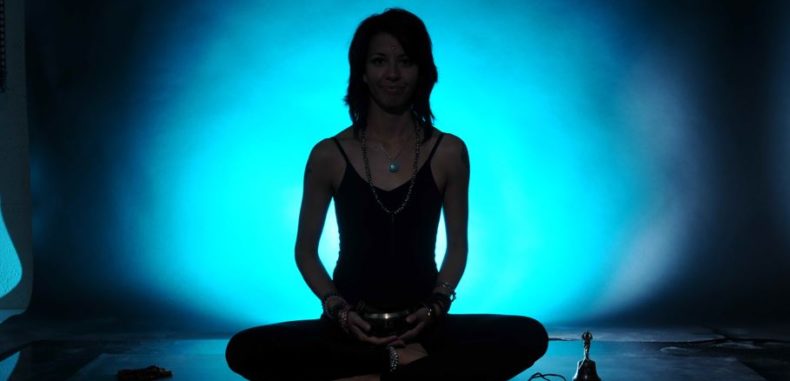Each of the seven chakras are governed by spiritual laws, principles of consciousness that we can use to cultivate greater harmony, happiness, and wellbeing in our lives and in the world.
The First Center: The Root Chakra
The root chakra, known in Sanskrit as muladhara, is located at the base of the spine. It governs your most basic survival needs. When this chakra is clear and energy flows through it freely, we feel secure and confident that we can easily fulfill our needs. However, blockage in this area can cause us to feel anxious and worried.
The spiritual Law of Karma governs the first energy center. On the physical plane, every action you perform results in a corresponding reaction. To maximize the possibility that your actions generate evolutionary reactions, you can use your body as a choice determining instrument.
Consider the possibilities in front of you and listen to signals from your body. These sensations generating from the root chakra are either comfortable or uncomfortable. Your body evaluates every possible decision in terms of its likelihood to meet your needs for safety or increase the level of threat you experience. The first chakra, which connects you with the earth, provides essential information as to the potential nourishment or toxicity that is available to you as a result of the actions you are taking.
The Second Center: Creativity Chakra
The creativity chakra, called svadhishtana, is associated with creativity in all its expressions. Located in the area of your sexual organs, the energy of this center can be used for biological reproduction. When channeled into higher energy centers, it fuels the creative force that enables you to paint a beautiful picture, build a business, or create a life of love and abundance.
The Law of Least Effort is lively in the second chakra. When your vital energy is flowing through your center of creativity, you co-create your life. The solution to every problem is rarely on the level of the problem. Rather, it comes from a deeper domain of creativity. Creativity is the process of taking the same raw material and creating different contexts and relationships between the components.
For example, when a composer creates a new piece of music, he is using the same notes in a new relationship with one another other, resulting in the emergence of something that did not exist before. The second chakra utilizes the raw material of the root chakra to create the world anew each day.
The Third Center: Energy Chakra
The energy chakra, manipura, is localized in your solar plexus. It’s the seat of your power in the world. When this center is open and flowing, you are capable of translating your intentions and desires into manifestation. When it is blocked, you feel frustrated and ineffectual.
The Law of Intention and Desire governs the third chakra. The seeds of intentions and desires reside in your personal soul. Nourishing the seeds you wish to germinate with your attention will lead to their full expression. It is important to be clear about your intentions so you are not surprised when they bear fruit.
The process of manifesting your desires is to first bring them into consciousness, followed by expanding your awareness through meditation, and finally releasing your intentions and detaching from the outcome. You can control your actions, however you cannot control the fruit of your actions. Keep your life energy flowing freely through your third chakra and the light and heat of your intentions will radiate on the world.
The Fourth Center: Heart Chakra
The heart chakra represents the unifying energy of love and compassion. Known as anahata, it is located at the center of the chest. The heart chakra is dedicated to overcoming separation and division. When the heart center is blocked, there is a sense of alienation from others. When the heart center is open and flowing, you feel connected at a deep level to all beings in your life.
The Law of Giving and Receiving governs the heart chakra. Love can take many different forms at different stages of life. The love of child for her mother is different than a mother’s love for her child. A friend’s love is different than that of a passionate lover or the love of a student for his teacher. However so, the common thread in each of these expressions of love is the impulse to unify—to overcome separation. This is the nature of the heart.
Every act of giving is simultaneously an act of receiving. Each time you welcome a gift into your life, you are providing the opportunity for someone to give. Just as a healthy physical heart receives blood from the periphery which it then oxygenates and pumps back out, your emotional heart stays healthy by receiving and giving love in all its forms.
The Fifth Center: Expression Chakra
The throat chakra, called visshuddha in Sanskrit, is the center of expression. When the fifth chakra is open and flowing, you have the confidence that you are capable of communicating your needs. When the fifth chakra is obstructed, a person will often feel that they are not being heard. In order to feel alive and empowered, it’s important that this energy center is clear. Blockages in this area are often associated with thyroid problems or chronic neck pain.
The Law of Detachment governs the throat chakra. An open fifth chakra enables you to express your truth without concern for censors or critics. This does not mean you say things that are intentionally hurtful or insensitive. On the contrary, people with open centers of communication are skillful in expressing their needs in ways that are life supporting. Anxiety over how people will react to your views does not arise when energy is flowing freely through the chakra of expression.
The Law of Detachment reminds you that you can choose your words and actions, but you cannot control the response to your words and action. When your intentions are clear, and your heart is open, you will spontaneously demonstrate right speech trusting that the universe will handle the details.
The Sixth Center: Intuition Chakra
The intuition chakra, known in Sanskrit as ajna, is located in the forehead. It is the center of insight and intuition. When this center is open, you have a deep sense of connection to your inner voice, and feel guided in your choices. When blocked, there is a sense of self-doubt and distrust. The opening of this chakra is usually associated with a clear sense of connection to ones dharma, or purpose in life.
The Law of Dharma or Cause and Effect governs the sixth chakra. You have within you a wise voice guiding you to express the highest aspects of your nature. Listen to this still inner voice, which is guiding you to manifest your full potential. Quiet the internal turbulence that is filled with the voices of others so you can identify the sound of your own soul. It has only one desire—for you to remember your essential nature as a spark of the divine.
The Seventh Center: Consciousness Chakra
The consciousness chakra, known as dahaswara, is visualized as a lotus flower at the crown of the head. When the lotus unfolds its petals, the memory of wholeness is restored. Remember that your essential nature is unbounded, and that you are spirit in disguise as a person. This is the full expression of yoga – the unification of being with action, of universality with individuality.
The Law of Pure Potentiality governs the seventh chakra. When your roots are receiving nourishment from the earth in the first chakra, your creative juices are flowing in the second, your intentions are empowered in the third, your heart is open and exchanging love with those around you in the fourth, you are spontaneously expressing your highest self in the fifth, you are in touch with your inner voice in the sixth, only then, does energy move into the crown chakra and you remember your essential nature as infinite and unbounded. The thousand-petaled lotus flower unfolds and you know yourself as a spiritual being temporarily localized to a body and mind.
The Yoga of Meditation The Upanishads tell us, “As great as the infinite space beyond is the space within the lotus of the heart.” From the time of your birth, you have been called to explore the world outside of you. Meditation is the exploration of your inner world. Yoga encourages you to be as familiar with your inner world of thoughts, feelings, memories, desires, and imagination as you are with the outer world. When you can move through both the inner and outer domains of life with freedom and joy, you fulfill the highest purpose of yoga.
Deepak Chopra, M.D. co-founded the Chopra Center for Wellbeing in 1996 with the late Dr. David Simon, who co-wrote this article and the book The Seven Spiritual Laws of Yoga. You can learn more by visiting the Chopra Center’s resource page.


















Some advanced persons have even more chakra’s. 8,9,10 or more and connecing to higher dimensions
The highest chakra connects directly to the central galactic sun (12th’ ? not sure wich)